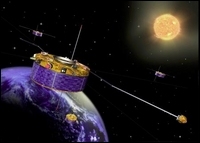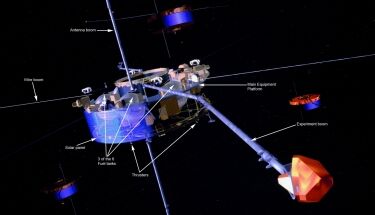Spacecraft
Why are there four identical Cluster spacecraft?
 |
|
Artist's impression of the four Cluster spacecraft, flying in tetrahedron formation |
When they are only a few hundred kilometres apart, they will be able to study small-scale features in the surrounding space. At other times, they may be separated by up to 20 000 kilometres, to obtain a broader view of what is going on.
The satellites will follow highly elongated, polar orbits which take them between 19 000 and 119 000 kilometres from the planet. Sometimes, they will be inside the Earth's magnetic shield and sometimes they will be outside, fully exposed to the supersonic solar wind.
Spacecraft vital statistics
|
Diameter: |
2.9 m |
|
Height: |
1.3 m |
|
Mass: |
1200 kg |
|
(of which) Propellant: |
650 kg |
|
(of which) Scientific payload: |
71 kg |
|
Solar array power: |
224 W |
|
Spin rate: |
15 rpm |
|
Operational lifetime: |
Nominal 27 months |
Four giant 'Lego' sets
The Cluster spacecraft resemble giant 'Lego' sets, assembled by hand from thousands of individual parts. Each one is shaped like a giant disk, 1.3 m high and 2.9 m across. In the centre is a cylinder with an aluminium honeycomb structure covered with a skin of carbon-fibre reinforced plastic. The equipment panel inside this cylinder supports the main engine, two high-pressure fuel tanks and other parts of the propulsion system.
 |
|
Cutaway of a Cluster spacecraft, showing its main structural features |
Six spherical fuel tanks made from titanium are attached to the outside of this central cylinder. The fuel they carry accounts for more than half the launch weight of each spacecraft. Most of this fuel will be consumed soon after launch, during the complex manoeuvres required to reach their operational orbits. Each spacecraft also carries eight thrusters for smaller changes of orbit.
Around the central cylinder is the main equipment platform. It consists of an aluminium-skinned honeycomb panel, which is reinforced by an outer aluminium ring. Most of the subsystems, such as the power and computer processing hardware, are attached to its lower surface, while the science experiments are placed on top. Electrical power is provided by six curved solar panels attached around the outside of the platform. Five silver/cadmium batteries are used for power supply during the four-hour-long eclipses when the spacecraft enter Earth's shadow.
Various rod-shaped booms open out once the satellite reaches orbit. They include two single-hinged antennae for communications and two five-metre, double-hinged booms on the satellite's upper surface which carry sensors which would otherwise be disturbed by the spacecraft. There are also four 50-metre-long wire booms which deploy radially when the spacecraft begins to spin. These measure changing electrical fields around each spacecraft.
